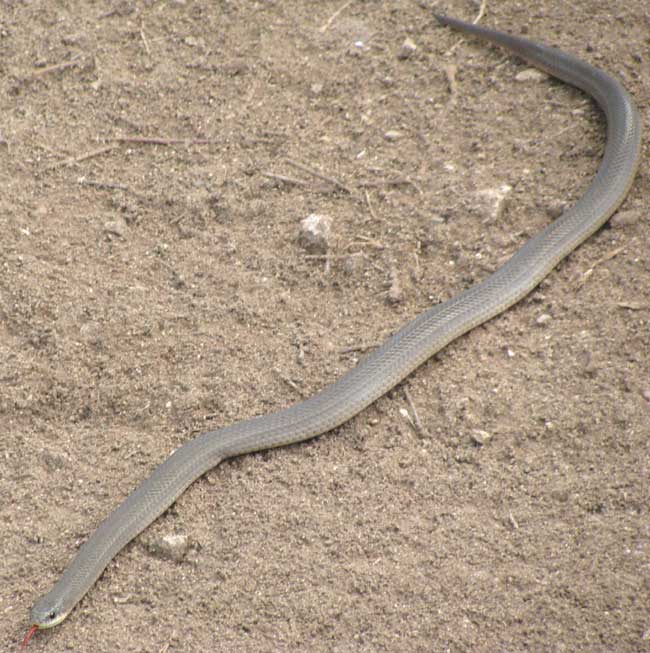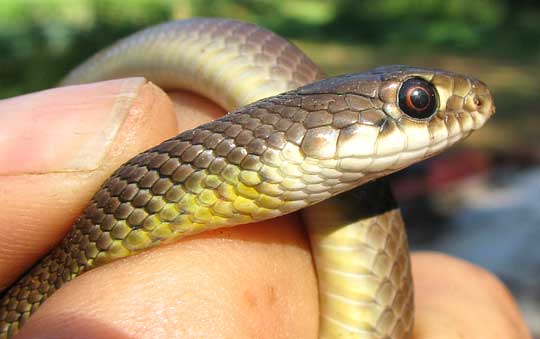Excerpts from Jim Conrad's
Naturalist Newsletter

From the December 19, 2004 Newsletter issued from near Dzemul, northwestern Yucatán, MÉXICO
SCORPION-HUNTING SNAKE
Monday afternoon a commotion erupted among the chickens and Ana Maria got there just in time to keep a little snake from being hurt too much. The snake was about fifteen inches long with an unusually blunt head, a short, thick tail, and a very pretty color, a kind of rosy-cream. It was the Scorpion-hunting Snake, STENORRHINA FREMINVILLEI.
The snake behaved as if it had been handled as a pet every day of its life. I don't think I've ever seen such a peaceful, pleasant snake of this size.
We could identify the snake because Ana Maria had a book about the snakes of Chiapas, Mexico's southernmost state, and this species, perhaps because it's so pretty and interesting, happened to be described and illustrated.
The snake mainly eats insects, spiders and scorpions. To deal with the dangerous stingers of the latter, the snake has evolved a simple but effective behavior: The moment it captures a scorpion it contracts its body in such as way that its scales overlap, effectively increasing its armament. At the same time, the snake coils its body around the victim so the scorpion can't position its stinger for a jab.
By the time we'd found some scorpions to feed it, it'd escaped, and I can't even find a picture of it on the Internet so I can show you what it looked like. That snake came and went like a chimera leaving no trace, and I suppose that that's befitting such a pretty one.
from the February 28, 2010 Newsletter issued from Hacienda Chichen Resort beside Chichén Itzá Ruins, central Yucatán, MÉXICO; limestone bedrock, elevation ~39m (~128ft), ~N20.676°, ~W88.569°
SCALES ON A SNAKE HEAD
Walking across the employee's volleyball court next to the church this week I came upon a two-ft snake, shown above. Its lack of conspicuous field marks suggested that it'd be hard to identify this snake without knowing some technical features, so I caught it and made some close-up pictures, one of them shown at the top of this page below:

In identifying look-alike snake species, nothing is as helpful as the scale patterns, especially those on the head. Scale patterns are pretty stable within species, but they vary consistently among the species.
The scales on this snake's head showed up so nicely that I created an image for my website's snake identification page, labeling each head scale, shown below:

From Jonathan Campbell's Amphibians and Reptiles of Northern Guatemala, the Yucatán, and Belize I made a list of all the snake species it could be, based purely on whether they were present in the Yucatán, and whether the illustrated snake halfway looked like my badminton snake. Here was my list of possibilities:
- Common Tropical Ratsnake
- Yucatán Dwarf Centipede-eater
- Mayan Golden-backed Snake
Of these I least thought it would be the centipede-eater because those are smaller. Campbell says that Yucatán Dwarf Centipede-eaters usually have 6-7 supralabial scales, while ours has 8. They have 6 infralabials, while ours has 7. Also, they have NO loreal scales, while ours has a good one. Therefore, this is not a Yucatán Dwarf Centipede-eater.
Next, the head shape didn't seem quite right for it to be a Common Tropical Ratsnake. That species has 8 supralabials like ours, but 11 infralabials, while ours only has 7. The difference in infralabial number is so great that I disqualified the ratsnakes.
So, does our snake match the Mayan Golden-backed Snake's scales count? Campball says that that species usually has 6 supralabials while ours has 7. It has 8 infralabials, which ours also has. Anyone out there with a more expert opinion?